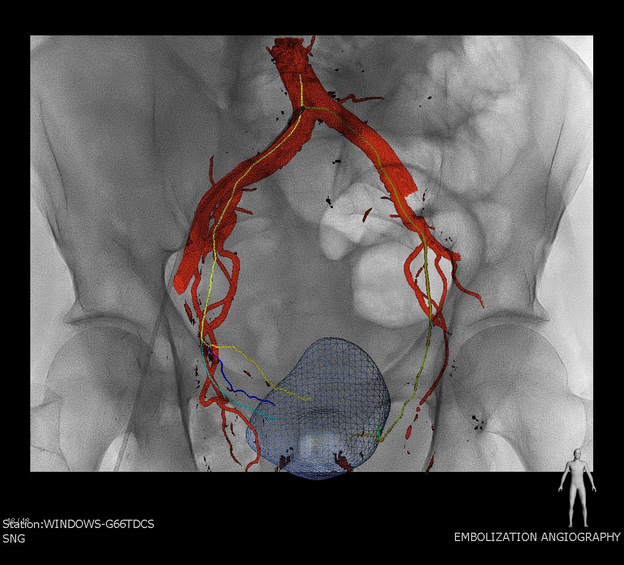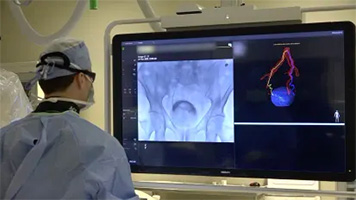Enlarged prostate, or BPH, symptoms affect approximately 50 percent of men in their 50s and as many as 90 percent in their 70s and 80s. As the prostate gland grows, it can slow or stop the flow of urine from the bladder—also called bladder outflow obstruction. Your symptoms may include frequent urination, the urgency to urinate, poor urine stream, and incomplete emptying of the bladder. BPH may also be a cause of hematuria or blood in one’s urine.
Prostate artery embolization (PAE) may be used to reduce the size of the prostate and relieve the bothersome lower urinary tract symptoms. PAE is a minimally invasive treatment that has less risk, less pain and less recovery time than traditional surgery. It also does not carry the risk of sexual side effects typically associated with invasive prostate surgeries. Improvement in symptoms can be seen as early as 1 month after the procedure. Maximum benefits are seen at 6 months and are just as good a TURP.
 A 3D roadmap of the pelvic arteries and the prostate generated during a PAE
A 3D roadmap of the pelvic arteries and the prostate generated during a PAEThrough image guidance, an interventional radiologist makes a tiny incision in either the groin or the wrist to insert a small, thin tube called a catheter into an artery and directs it to the blood vessels of the prostate. Once there, the IR blocks the blood flow to specific areas of the prostate, depriving those prostate cells of oxygen and resulting in the gland’s shrinkage.
Men who have undergone PAE have reported high satisfaction, no urinary incontinence, or sexual side effects. Minor side effects, most of which resolve on their own, include frequent and/or difficult urination, pelvic pain, blood in the urine, blood in the stool, and diarrhea.
PAE is a safe and effective a treatment option for appropriately selected patients, particularly those who cannot tolerate surgery or have failed other medical therapy; older patients with multiple conditions; patients with very large prostates; patients with bleeding from the prostate or with long-term bladder catheters; patients who cannot stop anticoagulation therapies; and patients who desire to preserve sexual function.
More than 20 studies including over 2,000 patients with moderate to severe symptoms due to BPH show that PAE has shorter recovery and fewer complications than traditional surgery or TURP and improves symptoms and quality of life to a greater degree than medical therapy.*
Take this IPSS survey to see how severe your symptoms are. Bring it with you to your appointment to discuss your individualized treatment plan.
Varicocele is an enlargement of veins within the scrotum. Veins contain one-way valves that allow blood to flow from the testicles and scrotum back to the heart. When the valves do not work, the blood pools in the veins. Pooling of blood in these veins causes them to enlarge. The internal pressure and temperature may increase, possibly damaging the testicles and decreasing fertility. Symptoms of varicocele can include abnormal enlargement of veins in scrotum, dull ache or pain in the scrotum.
IRs treat this condition through a minimally invasive varicocele embolization. First, a tiny incision is made in the groin. Next, a thin catheter, resembling a strand of spaghetti, is passed through the vein and directed toward the varicoceles. The interventional radiologist injects X-ray dye to better see the veins. After locating the varicoceles, the interventional radiologist injects tiny coils to prevent blood flow to the varicoceles, reducing the pressure in the veins.


